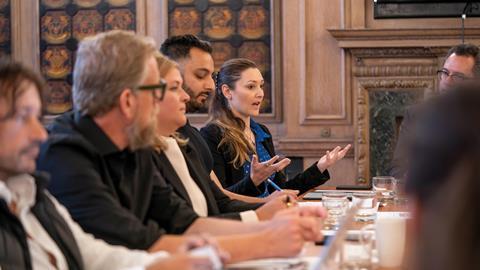The legal sector’s engagement with the staggering potential of artificial intelligence has surprised long-time observers of this traditionally cautious profession. Joanna Goodman reports from the Gazette’s latest roundtable discussion
At the table
(Left to right) Abbas Khan eBrevia; Joanna Goodman Law Society Gazette; Andrew Cooke TravelPerk; Adam Nguyen eBrevia; Peter Harris Bird & Bird; Anne Wong Norton Rose Fulbright; Rowena Rix Dentons; Tania Brodie-Clarke Norton Rose Fulbright; Eduardo Reyes Law Society Gazette; Anthony Kenny GSK; Alessandro Galtieri Colt Technology Services; Evan Flowers Dechert; Stuart Whittle Weightmans (not shown)

The transformative power and potential of generative artificial intelligence (GenAI) is a hot topic across all sectors. And law, which is often lagging when it comes to tech, is in the vanguard of change. Perhaps this is not surprising. Large language models’ conversational interface can generate, interrogate and summarise text, and pretty much everything in the law eventually comes down to a document.
There is now a huge range of GenAI solutions for law firms and legal departments, from established tech and legal tech vendors and law tech start-ups and scale-ups. Larger firms and legal departments are developing their own bespoke tools. This Gazette’s roundtable, sponsored by eBrevia, looks at how law firms and corporate legal departments are currently using AI, and the impact it is having on processes, people and technology, including ongoing concerns around risk, regulation and supervision.
Peter Harris, applications developer at Bird & Bird, explains that when OpenAI’s GPT models first emerged, GenAI was envisaged as ‘an everything engine’ but early use cases made common processes more efficient.
His firm uses Power Automate, part of Microsoft’s suite of products, ‘to connect processes across Microsoft applications’, Harris says. ‘And combining Power Automate with GPT gives you extremely powerful data extraction, and many of our processes… [involve] extracting key data from hundreds of documents and putting them in a structured form [so that they can be reused]. The next step was to apply GPT models to previous cases, using OpenAI Playground.’
Being a technology law firm, partners and business services were keen to get involved, so Bird & Bird quickly established a risk policy around GenAI use. Making ChatGPT available produced a lot of ideas, some of which were piloted using Power Automate, which enabled the firm to develop ideas without incurring high costs.
‘Obviously, GPT is not the answer to everything,’ Harris says. ‘But we are building a library of knowledge. We also use older GPT models because they are more stable and use fewer tokens. The next step was to create our own large language models, and to trial [Microsoft] Copilot around the firm – with mixed results. The firm has expanded its skills base by hiring a new head of innovation and technology, Hélder Santos, who is in charge of rounding up all the ideas.’
He adds that the firm is also piloting legal-specific GenAI applications through trials around the firm.
'As a legal team we are very much focused on governance, but we want to allow creativity, while focusing on data and emerging regulation too'
Anthony Kenny, GSK
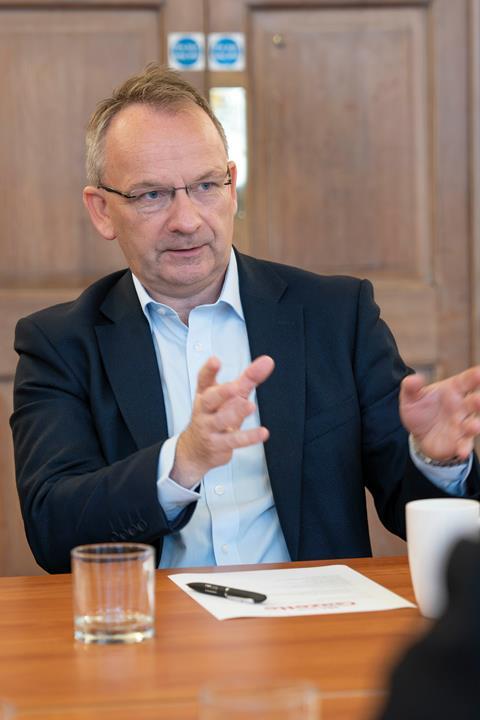
Anthony Kenny, GSK’s legal director for the UK and Ireland, explains that the legal department has to align itself with a business where everyone is encouraged to use GenAI. ‘Rather than being afraid that AI will replace jobs, [our approach is] let’s see how we can use this technology and what it can do for us,’ Kenny says. ‘At GSK we have an internal tool, GG, which is essentially our own ChatGPT, that allows us to play with GenAI within the GSK environment. We are also allowed to use ChatGPT on the understanding that we don’t upload GSK data. And some of us are using Microsoft Copilot.
‘GSK already uses digital technology to develop drugs, and interact with patients and doctors, so as its lawyers, we have to keep up with this technology both to be more efficient and productive, and because we have to understand what they are doing [in the business] and stay ahead of the curve. And as a legal team, we are very much focused on governance, but we want to allow creativity, while focusing on data and emerging regulation too. So it’s not just about how we should use it to make ourselves more efficient, but understanding how the business is using it too.’
AI as a differentiator
Technology-assisted review (TAR) is an established part of standard e-discovery in complex corporate cases and M&A due diligence. Evan Flowers, a disputes partner at Dechert, specialising in government enforcement and investigations, sees GenAI as a huge opportunity for law firms.
‘It’s democratised creativity so you now see very senior people deferring to people who used to be referred to as support staff,’ Flowers observes, ‘and very well-regarded corporate lawyers who are now acting as directors of innovation, overseeing software development.’
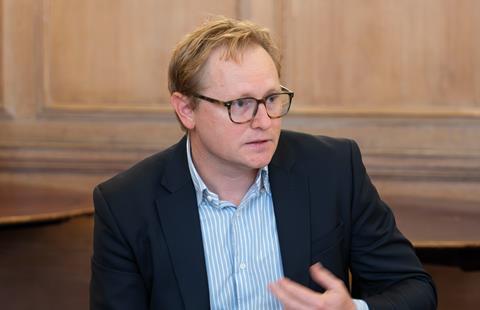
He reminds the group that ‘it took a long time to convince the Serious Fraud Office to accept TAR, eight years ago, and that was seen as a great leap forward. Now language sampling techniques seem almost Palaeolithic compared with what we have now. TAR improved the dialogue between regulators and companies, but it also created challenges because the [US] Department of Justice is using confederated datasets to identify when new cases are coming up. So the challenge is to try to get inside their minds and think about how they’re using the technology at the same time as creating efficiency for clients by getting to the best, most interesting information quicker.’
'Becoming part of [clients’] real-time decision-making helps us understand their business, and allows us to demonstrate our value, in terms of solving problems'
Evan Flowers, Dechert
Dechert, like other firms has developed internal GenAI resources, notably DechertMind, a proprietary version of ChatGPT. However, Flowers observes that GenAI is likely to create tension as some practice areas will be able to reap massive benefits from using it successfully, while others will see less impact.
The immediacy of GenAI is benefiting client relationships. Flowers says: ‘Becoming part of [clients’] real-time decision-making helps us understand their business, and allows us to demonstrate our value, in terms of solving problems.’
GenAI is becoming a differentiator for corporate legal when appointing external counsel. ‘It won’t be long before we start including it in our RFPs [requests for proposals], and at some point it will start to get into discussions around pricing too,’ says Kenny.
Higher legal fees are leading corporate legal departments to equip their own lawyers with GenAI technology and training, affecting how they manage the cost of external counsel. Alessandro Galtieri, deputy general counsel at Colt Technology Services, explains: ‘We tend to ask for a package solution for a particular deal, not necessarily a fixed price, but a ballpark figure which means that the business risk of lawyers putting in more hours is with the firm, not the client, so GenAI also becomes a way for law firms to use technology to retain their margins.’
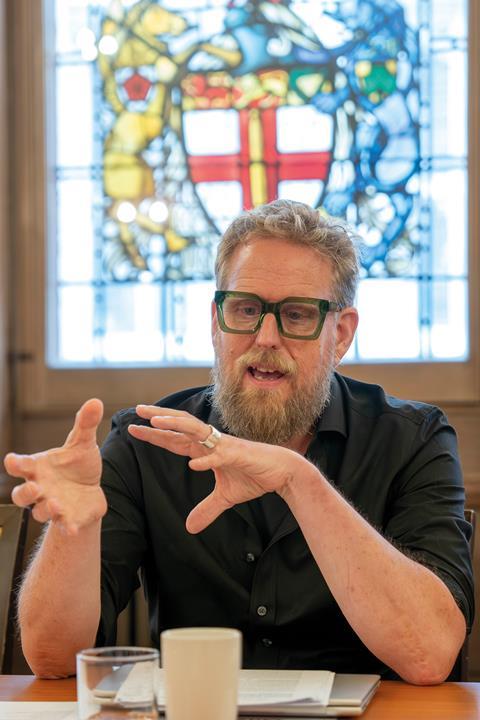
Art of the possible
Rowena Rix is head of innovation and AI for Dentons UKIME. In 2023 Dentons introduced its proprietary GenAI chatbot FleetAI, which has improved digital literacy, across the firm. ‘It was important to give people that safe environment for experimentation, and get them familiar with LLMs… it opened the door to the art of the possible,’ she says. ‘We spent a huge amount of time on engagement, and the shift has been phenomenal.’
Rix explains that in addition to the common GenAI use cases – summarisation and redrafting – the firm is developing vertical solutions in different practice areas.
'We have to look at the use cases in the context of making the end-to-end process as seamless as possible for our clients'
Rowena Rix, Dentons
A former litigator, Rix agrees with Flowers that the general acceptance of TAR in the courts paved the way for further development. She says: ‘I’m being brought into meetings with clients where I am asked “What have you got in your technology stack? How are you using it? How does it interact with the technology that we’ve got?” It’s not just about AI, so we have to look at the use cases in the context of making the end-to-end process as seamless as possible for our clients. Ultimately it’s about the user experience, whether internally or on the client side.’
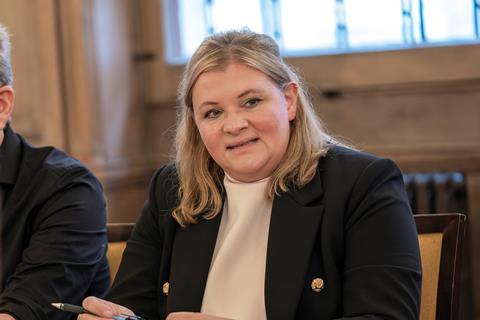
Adam Nguyen, CEO of roundtable sponsor eBrevia, co-founded the company in 2011, applying ‘classical AI’ in the form of machine learning and natural language processing to perform contract review, analysis and automation, to help law firms, alternative legal service providers, big consultancies and their corporate clients streamline their legal operations.
Having bought back the company (which he had sold in 2018) in late 2023, he introduced GenAI to increase and accelerate its capabilities, utilising multiple large language models to diversify the concentration risk. The technology has evolved, but the drivers are unchanged: the explosion of data and the need to generate, process and synthesise increasingly complex contracts.
‘Contracts touch every part of an organisation from supply chain management to risk and compliance, to customer management,’ Nguyen says. ‘Contracts govern what you do in an organisation, and how a business is run. Now, instead of just reviewing the data, law firms and corporates are saying, “We want to generate contracts quickly, efficiently and cost-effectively, in our own form of language using our own playbook, and we don’t want to share all our information with OpenAI.” Our latest product, DraftPro, which is in limited release mode, is helping users generate contracts much more quickly. But on the other side, they will need some sort of technology to process and synthesise all that information.’
GenAI is changing supplier relations
Abbas Khan, senior director EMEA at eBrevia, works with law firms and corporates to help them implement technology into their existing/ideal workflows and, like Peter Harris at Bird & Bird, Abbas works with users who use tools like Power Automate to integrate them into existing systems (alongside eBrevia’s own connection capabilities to over 2,000 systems).
Consequently, Khan finds that ‘rather than looking for a vendor to supply a solution, they are looking for a steadfast partner to help them get as close to their ideal outcome as possible. For us, it’s about taking time to really understand where they’re trying to get to, and how we can help them achieve this. That means the kind of deployments we see are really varied. We help with M&A due diligence, entire legacy digitisations, and we also get involved in regulatory changes such as the Digital Operational Resilience Act, LIBOR, Schrems II and other compliance items, key parts of which include integration with different systems. For example, a client may want a workflow that’s integrated with a legacy system like SAP Ariba which they may have used for years’. This type of strategic partnership includes helping organisations choose where AI is most effective to support their operations, working from the problem to the solution rather than trying to sell them something they don’t need.
CEO and co-founder Adam Nguyen (pictured below) advises organisations looking at GenAI to ‘focus on what you are trying to solve, rather than whether or not to use AI’. And on the exponentially growing choice of AI options, he adds: ‘The temptation is to wait for a perfect comprehensive, end-to-end solution, but that doesn’t exist. So, instead, find something good and use it, and make sure the solution evolves with your firm.’
The same principle applies to firms building their own GenAI solutions, he says: ‘Once you build something it’s an ongoing investment. There’s always more maintenance, development and improvement. It’s like buying a house. There’s always something to fix.’ It is equally important to combine the tech side of development with domain expertise, to work with the lawyers, who understand the processes, to make the solution user-centric, and to avoid being led by engineers.
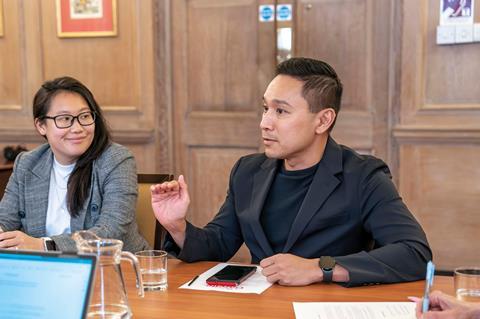
Delivering more with AI
Galtieri, who is testing Microsoft Copilot with his team, emphasises the importance of human behaviour: asking Copilot to summarise long email chains is a disincentive to write the short, succinct emails that he is looking for from his team and external lawyers.
However, he adds that generative AI can now be used to automate contract negotiations, and check insurance policies against playbooks/existing arrangements.
Nguyen comments that most organisations use AI for breadth – managing large volumes of data – or depth, for example, comparing new clauses to the ones most often used by the organisation, and making appropriate suggestions.
Andrew Cooke, GC of TravelPerk, an online business travel management platform, says: ‘We are more interested in how AI shines a light on our processes rather than accelerating existing processes, because doing a bad process more quickly is not a valid use case… So it’s not just about contract automation; rather, if we move to a point where we can make a wider range of standardised contracts available to people, they will accept that ultimately AI will be able to create all legal deliverables in a relatively short time.’
Cooke references Clayton Christensen’s The Innovator’s Dilemma: ‘What law firms are trying to say is we have built the firm that will eat our firm eventually, but it’s ours.’
‘Law firms, and other companies [have to decide] whether to [build their own GenAI solutions or] wait for a leader in the market to license this stuff and then just use it,’ says Flowers. ‘Why would lawyers want to pass ourselves off as software developers? It’s because things are moving so quickly that if we wait, we risk being behind the curve. So we have to invest in a targeted way, because we need to be able to demonstrate our value and in order to do that, we need to know how clients are analysing our value too.’
Flowers recalls that ChatGPT emerged after law firms had started to focus on disruption and innovation: ‘ChatGPT turbocharged legal innovation. The difficulty is deciding how much we need to invest to safeguard our future.’
Responding to Cooke’s comment about the futility of using GenAI to speed up/automate bad processes, Kenny questions whether the current contracting model is broken. ‘AI is giving us the opportunity to shine a light on what lawyers are doing,’ he says. ‘We have already heard from firms who are developing their own individual [large language] models, and there will be more. But is that the right thing to do? Should individual firms be differentiating themselves by a particular angle on AI, or would it be better for firms to collaborate, either across the whole industry, or sector by sector?’
Tania Brodie-Clarke, innovation lawyer at Norton Rose Fulbright (NRF), mentions law firms’ challenges around establishing acceptable risk frameworks for integrating GenAI tools into existing systems and data repositories.
NRF is adopting a process-driven approach, looking at how to add value beyond doing things faster. She is already seeing a change in the market, and RFPs that include questions about AI solutions. ‘It’s important not to say we’re using AI on everything,’ she says. ‘Our focus is a combination of exploring where it is beneficial, and the change management piece. Ensuring our people have data literacy is important because lawyers don’t have much extra time to invest in playing with these tools.’
When it comes to risk mitigation, Brodie-Clarke observes, GenAI adoption includes user education, to ensure that lawyers understand how GenAI works and its potential risks.
Two-tier legal system?
Stuart Whittle, business services and innovation director at Weightmans, flags up the GenAI divide between large firms with innovation and compliance teams, who hire developers who understand where to apply it and help people to use it safely, and smaller firms. The latter are ‘terrified because they think there will be a two-tier legal system whereby firms who act for big corporate and public sector bodies will have a lot of power because they deploy large language models, whereas they [the smaller and mid-size firms] act for individuals. They don’t have the time, resource or ability to understand how this stuff works and what the risks are,’ he says.
Turning to GenAI and efficiency, Whittle references the Jevons paradox in economics, that in the long term an increase in efficiency due to technological progress will increase (rather than decrease) consumption. ‘So if you improve the efficiency of text generation, all you’re going to get is more words, and as coders we know that more code isn’t necessarily more efficient. Efficient isn’t about generating more words faster. When email first came in, it was really efficient and effective. But as the cost of creating content went down, we got more content and we had to invent an entire set of technology to deal with it. So we have to think about what we mean by efficiency.’
New technology brings new risks, and as Brodie-Clarke observes, lawyers are inherently focused on avoiding risk. She adds that because GenAI systems and use cases are evolving rapidly, there has to be some flexibility in terms of risk tolerance.
Governance frameworks and acceptable usage policies help firms manage this. Whittle does not believe that GenAI will change the risk appetite at Weightmans, because innovation is managed by a comprehensive governance framework. Harris at Bird & Bird adopts a similar policy predicated on transparency and trust.
Kenny concludes by stating the current position succinctly: while there will always be risks, laws and regulations around AI, ‘what can change is the governance and the flexibility and agility of how you manage and assess the risks, which we are all having to do quicker. And there is more of a willingness, especially given the massive potential of this technology, to try to challenge and address its risks’.
This roundtable discussion was kindly sponsored by eBrevia
Photographs by Noah Da Costa























